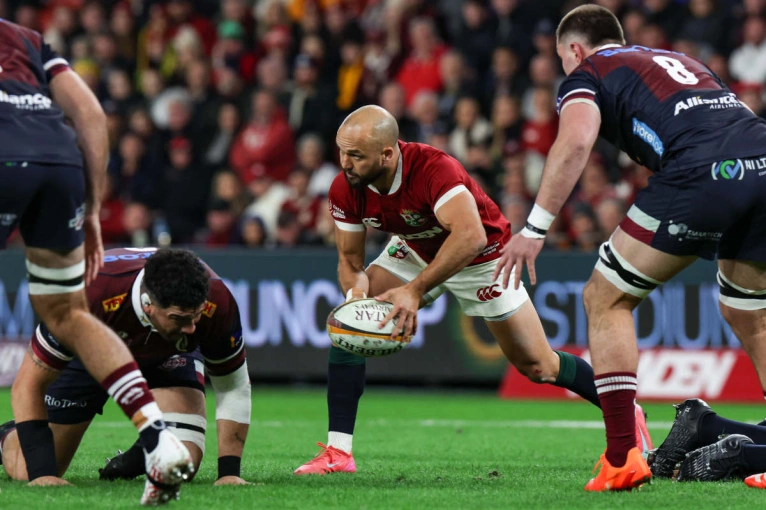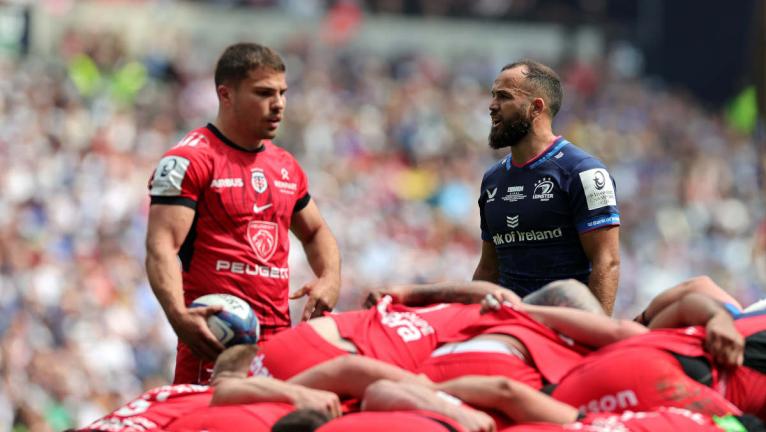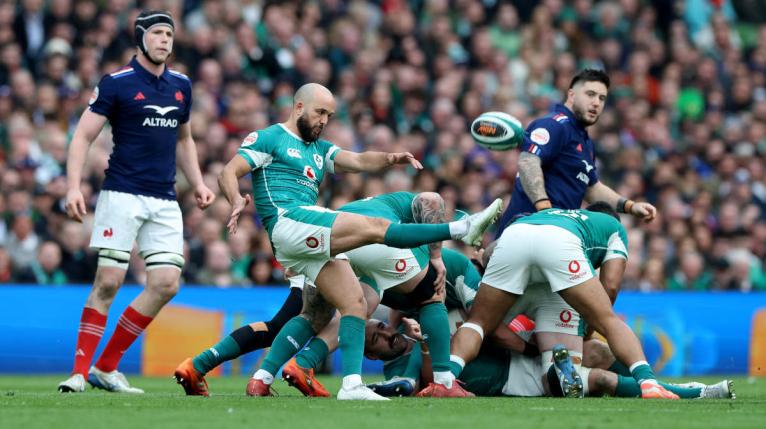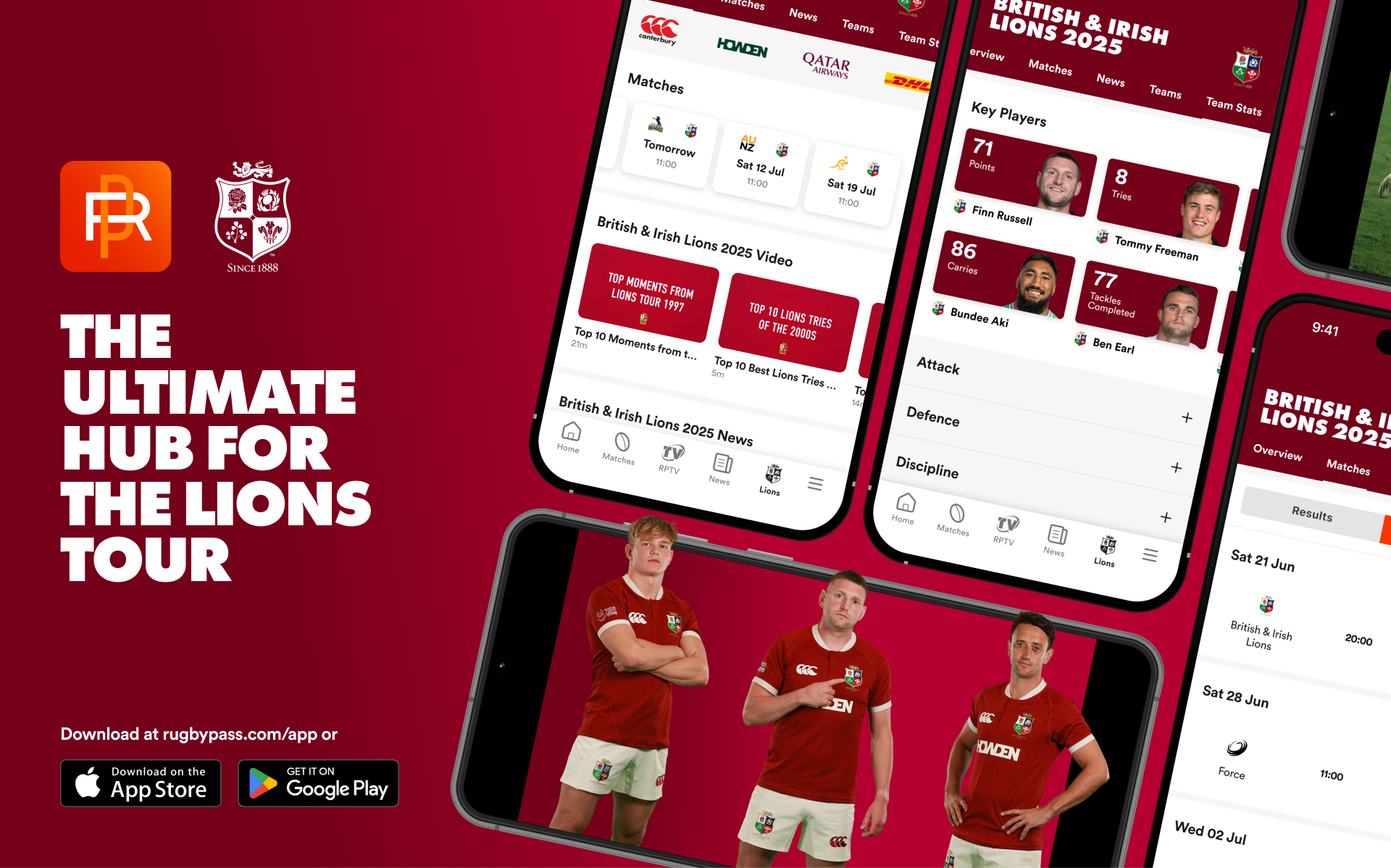The man in charge of the PA system ran through the Lions team sheet with caustic wit. Mack Hansen, the Irish winger, was introduced as a former Aussie; James Lowe was dubbed a Kiwi; Pierre Schoeman, a former South African schoolboy.
Although they were unable to see the crowd, there was no ignoring the cheers of the Western Force fans. This was world class trolling, funny or crass depending on your sense of humour or sense of belonging.
Had he been selected, you wonder what words the stadium announcer would have found for Jamison Gibson-Park, the Ireland scrum-half. Would he have referenced his upbringing on an island populated by 938 people, dubbed ‘the place that time forgot’ by the New Zealand Herald?
There were times when Gibson-Park must have wondered if he was the player that rugby forgot. A career journeying around New Zealand’s franchises included one season when he didn’t start a game, his role as understudy to TJ Perenara doing nothing for his confidence. “I was coming off the bench pretty much every week so you just go through the motions,” he said two years ago.
He couldn’t have imagined then what would subsequently transpire – the call from Ireland, the move to Dublin, the trophies with Leinster, this strange thing called a residency rule which allowed him to represent a country he had never set foot in until 2016.

Then, finally, there was an international debut at 28 … yet this wasn’t a fulfilment of a childhood dream because this debut was in an Irish rather than an All Black shirt and took place in an empty stadium, smack in the middle of lockdown. In a sense it seemed appropriate that a boy brought up in the Great Barrier Island had a psychological barrier of his own to overcome before he realised he merited a place on the international stage.
“There were periods when I probably lacked a little bit of self-confidence,” Gibson-Park reflected on debut day. “You feel as if you won’t get there. But I think everyone has those passages (at some point) in their career.”
His words needed editing because there weren’t ‘passages’ of doubt Gibson-Park experienced but years of it. These days he is considered one of the best scrum-halves in the world, Ronan O’Gara dubbing him second only to Antoine Dupont during his commentary on the Lions’ midweek victory over the Reds, Dan Biggar calling him ‘conductor of the Lions’ orchestra’.
These were the kind of things he needed to hear early in his career, when he suffered from imposter syndrome, wondering if he was good enough, before he realised that ‘sticking to his guns’ and trusting the warrior-like determination that saw him earn his first professional contract, was worthwhile.
Jamison brings tempo and off-the-cuff-type feel to the game. He plays what’s in front of him and he is dynamic. He has good footwork and he can ask questions of any defence. And his game control is pretty good on the back of that.
Andy Farrell
It helped to have a coach who trusted him. Andy Farrell did, with Ireland firstly, now with the Lions. But he wasn’t the only one. Stuart Lancaster, once Farrell’s boss at England, later the senior coach at Leinster, brought out the ‘personality’ in Gibson-Park.
“Jamison brings tempo and off-the-cuff-type feel to the game,” Farrell said after making a seismic call in 2021 to drop Conor Murray, with his 88 caps, for Gibson-Park, with his eight. “He plays what’s in front of him and he is dynamic. He has good footwork and he can ask questions of any defence. And his game control is pretty good on the back of that.”
It always was. Colin Cooper noted it when he called a 21-year-old Gibson-Park into the New Zealand Maori side, having seen his work up close with Taranaki.
“His conditioning is huge,” Cooper said in an interview three years ago, explaining a pre-season drill where they used to run 22 metre shuttle sprints. “He could run them in 19/20 seconds; if you’re reaching under 16 you’re too slow. Usually your frontrowers are around 16, and your backs and your fast boys get to 18, some maybe to 19. He recorded a 20.2 with us. I had two of them in the 20s, and he was one of them. He had super speed times.”

Farrell identified that at a time when Gibson-Park was second choice at Leinster behind Luke McGrath, catapulting him into the Ireland squad at a time when the coach was under a fair degree of pressure.
It proved a masterstroke.
Aside from Cooper who persuaded him to add box-kicking to his repertoire, Farrell has been the most influential figure in Gibson-Park’s life.
While he won things in New Zealand – Taranaki’s first Premiership NPC in 2014, the Hurricanes’ Super Rugby crown in 2016 – the big thing Gibson-Park never won on Kiwi soil was respect. At the Blues, he was Piri Weepu’s understudy, then Jimmy Cowan’s. The Hurricanes called in 2016 but each of his 13 appearances for them were as a replacement for TJ Perenara.
The problem for Gibson-Park in that period of his career was his lack of physique and by extension his predictability. Defences knew he wasn’t a threat, more of a box ticker. If the pass was on, he passed it; if the ball needed to be cleared, he cleared it. You could have sworn he was operating by remote control. But that was then. The change in his game came because there was also a change in him as a person.
“A big thing he had to work on was his voice, because he’s quiet and shy,” said Cooper.
You can understand that. While he moved to the large town of Gisborne when he was 11, those initial years on a small island were formative, and it took years of coaxing from Lancaster, then Farrell, for him to find the confidence to speak up.
He’s very down to earth, Jamo, he’s very humble and hard-working. To be an international player, you have to believe in yourself first and foremost and he does. He is playing with a lot more control and confidence.
Stuart Lancaster
Selections didn’t help and nor did Heineken Cup restrictions which permitted only two non-European slots in any starting XV which were usually filled by Scott Fardy and James Lowe.
However, when McGrath was injured for the 2018 Champions Cup semi-final against Scarlets, it was Lowe who missed out. “There’s no doubt in my mind that Jamison is ready to play at this level,” said Lancaster prior to that victory, a critical moment in Gibson-Park’s maturation.
Four years later, by the time Farrell had moved Gibson-Park up ahead of Murray, Lancaster was once again asked about his protege’s growth. “He’s very down to earth, Jamo, he’s very humble and hard-working,” said the former England coach. “To be an international player, you have to believe in yourself first and foremost and he does. He is playing with a lot more control and confidence.”
Another corner had been turned, not just for Gibson-Park but also Ireland. After their stellar year in 2018, they had gone into a steady decline, first in Joe Schmidt’s final year, then in Farrell’s first. A big change was Gibson-Park’s introduction to the team, as well as other factors, Andrew Porter’s relocation across the front row; Caelan Doris’ arrival; a Leinster-heavy selection process.

Suddenly Ireland began to win again, defeating their 2019 World Cup conquerors, Japan and New Zealand, in back-to-back tests. This was what Perenara had to say then about his one-time understudy. “Everything Jamison touches often turns to gold. To see him come over here and be successful at club and international level has been awesome.”
To understand why we need to go back to the move Gibson-Park made when he was 24-years-old, arriving in Dublin in the summer of 2016, with his partner Patti, and their daughter, Isabella, who was then just 18-months-old. Fast forward four years to lockdown in Ireland. The Gibson-Parks were 12,000 miles away from home. He had yet to become a first-choice in international rugby. Some tough internal questions were asked.
“It’s not that I was faffing around but I was playing second fiddle at Leinster,” he said of that period in his life. “[I did wonder] just like whether I was going to give it a crack or not.”
Farrell answered that question for him, giving him his debut in 2020, making him first choice a year later. Leinster pretty soon saw what Farrell did and the islander from north of Auckland was promoted to their starting line-up.
This is Leinster hooker James Tracey: “Jamison’s a fairly humble guy but he’s also a free spirit and you could see that in how he played his range of passing, the offloads.
“As Irish players we’d learnt rugby as a structured game. He broke the mould. I think Andy Farrell has given him the environment to express himself and thrive, so what you’re seeing now is a mix of two things: structure and detail combined with an ability to do things out of the ordinary.”
His first year or so in Ireland, he was quiet. It took him a while to really understand that a top-class scrum-half needs to have a personality and be the captain of the team really in terms of driving everything.
Stuart Lancaster
Ireland needed that. In Japan at the 2019 World Cup, they were dull. Under Farrell, they went backwards before the head coach took greater control of their attack, and insisted upon them playing more quickly.
Gibson-Park was the catalyst behind that shift, his speed from ruck to ruck being faster than Murray; his willingness to break keeping defences honest; his grubber-kicks which led to a try for Andrew Conway against Japan in 2021, being a further asset.
Lancaster was impressed, pointing out in 2023 how more confident Gibson-Park was within himself. “His first year or so in Ireland, he was quiet. It took him a while to really understand that a top-class scrum-half needs to have a personality and be the captain of the team really in terms of driving everything.
“I think he has really grown that. It’s fine doing that in a Leinster environment where he knows everyone. Internationally, it’s different. If he was given the opportunity, that’s what I’d like to see from him – that same personality that has grown here and exists in this environment.”

Of his shyness, Gibson-Park has been open. “I was naturally pretty quiet,” he once admitted. “So, Stu (Lancaster) kind of got on my back and said, ‘Look, you need to do a bit more here’. He’s been awesome for that and I’m very grateful because otherwise I probably would have stayed the same quiet self.”
At Leinster, Lancaster did personality profiles of every player which helped them to see how everyone should be communicated with. “He worked very hard over the years to get more out of guys,” Gibson-Park admitted a couple of years ago.
And we can see the benefit now. In 2016, as a Hurricane, he was trusted for just three minutes of their Super Rugby final win over the Lions. The score was 20-3 when he was introduced, reinforcing the idea he was a token sub.
Now he’s anything but. At 33, he has become the best nine in the British Isles. These days in the unofficial world rankings, he is back-up to only one other scrum-half, the incomparable Dupont. This shy kid’s voice can now be heard all across the rugby world.
News, stats, videos and more! Download the new RugbyPass app, in collaboration with the British and Irish Lions, on the App Store (iOS) and Google Play (Android) now!



Great article until the last. When will you finally realise that Ireland is not part of the British Isles and hasn’t been for 100 years?
Long live the Irenzicanians.
As elegant a player as you can get.
Consistently among the very best players on the pitch most games. I think it was one of the Nov 2022 tests he was player of the match having spent the second halve playing as a winger.
Different gravy.
Good on him for taking his chances and becoming one of the top 5 half backs in the game. He was never going to make it into the NZ side but has become a leading figure for Ireland and now the Lion's.
At Canes he was skilled but was way less muscular and lighter he sometimes played quite passive snd could be bit dodgy on the tackle, but now what a player the maestro of setting tempo we missed one there
I thought he was the trickster of his teams? He had one video done of him and he looked a cheeky bugger. Maybe that was a mask at the time, but yep, showed a bit on the park but that was a time when they all started light.
I have just done a quick run through of SA born players playing international rugby in other countries and asked myself how many of them would be in the current Bok side. Schoeman and van der Merwe are probably the top two candidates, but I can’t see either replacing the incumbent starters or the bench. How many NZ born players playing overseas internationally now would have made it into the NZ side? I’m not trying to be provocative just interested in testing the difference in selection policies.